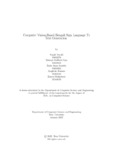| dc.contributor.advisor | Hossain, Muhammad Iqbal | |
| dc.contributor.advisor | Ahmed, Md. Sabbir | |
| dc.contributor.author | Tazalli, Tonjih | |
| dc.contributor.author | Liya, Sumaya Sadbeen | |
| dc.contributor.author | Aunshu, Zarin Anan | |
| dc.contributor.author | Hossain, Magfirah | |
| dc.contributor.author | Mehjabeen, Zareen | |
| dc.date.accessioned | 2022-06-08T04:50:14Z | |
| dc.date.available | 2022-06-08T04:50:14Z | |
| dc.date.copyright | 2022 | |
| dc.date.issued | 2022-01 | |
| dc.identifier.other | ID 18101176 | |
| dc.identifier.other | ID 18101152 | |
| dc.identifier.other | ID 18101183 | |
| dc.identifier.other | ID 18301210 | |
| dc.identifier.other | ID 21341059 | |
| dc.identifier.uri | http://hdl.handle.net/10361/16941 | |
| dc.description | This thesis is submitted in partial fulfillment of the requirements for the degree of Bachelor of Science in Computer Science and Engineering, 2022. | en_US |
| dc.description | Cataloged from PDF version of thesis. | |
| dc.description | Includes bibliographical references (pages 34-35). | |
| dc.description.abstract | In the whole world, around 7% of people have hearing and speech impairment problems.
They use sign language as their communication method. People from various
countries use a variety of sign languages. As an example, there are ASL, CSL, JSL,
etc. Even in our country, there are lots of people born with hearing and speech
impairment problems. So, our primary focus is to work for those people by converting
Bangla sign language into text. There are already various projects on Bangla
sign language done by other people. However, they focused more on the separate
alphabets and numerical numbers. That is why we want to concentrate on Bangla
word signs since these people prefer to communicate using words or phrases rather
than alphabets. There is not any proper database for Bangla word sign language, so
we are making a database for Bangla word sign language for our work. In recognition
of sign language (SLR), there usually are two types of scenarios: isolated SLR,
which takes words by word and completes recognize action, and the other one is
continuous SLR, which completes action by translating the whole sentence at once.
We are working on isolated SLR. We introduce a method where we are going to
use PyTorch and YOLOv5 for a video classification model to convert Bangla sign
language into the text from the video where each video has only one sign language
word. Here,we have achieved an accuracy rate of 76.29% on the training dataset
and 51.44% on the testing dataset. We are working to build a system that will make
it easier for hearing and speech-disabled people to interact with the general public. | en_US |
| dc.description.statementofresponsibility | Tonjih Tazalli | |
| dc.description.statementofresponsibility | Sumaya Sadbeen Liya | |
| dc.description.statementofresponsibility | Zarin Anan Aunshu | |
| dc.description.statementofresponsibility | Magfirah Hossain | |
| dc.description.statementofresponsibility | Zareen Mehjabeen | |
| dc.format.extent | 35 pages | |
| dc.language.iso | en | en_US |
| dc.publisher | Brac University | en_US |
| dc.rights | Brac University theses are protected by copyright. They may be viewed from this source for any purpose, but reproduction or distribution in any format is prohibited without written permission. | |
| dc.subject | Bangla sign language | en_US |
| dc.subject | Convolutional neural network (CNN) | en_US |
| dc.subject | Video classification | en_US |
| dc.subject | PyTorch | en_US |
| dc.subject | YOLOv5 | en_US |
| dc.subject | Image processing | en_US |
| dc.subject.lcsh | Neural networks (Computer science) | |
| dc.subject.lcsh | Image processing -- Digital techniques. | |
| dc.title | Computer vision-based Bengali sign language to text generation | en_US |
| dc.type | Thesis | en_US |
| dc.contributor.department | Department of Computer Science and Engineering, Brac University | |
| dc.description.degree | B. Computer Science | |

